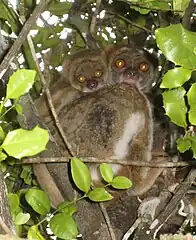| Avahi | |||
| Jourdan, 1834[1] | |||
 Przedstawiciel rodzaju – awahi wełnisty (A. laniger) | |||
| Systematyka | |||
| Domena | |||
|---|---|---|---|
| Królestwo | |||
| Typ | |||
| Podtyp | |||
| Gromada | |||
| Infragromada | |||
| Rząd | |||
| Podrząd | |||
| Infrarząd | |||
| Nadrodzina | |||
| Rodzina | |||
| Rodzaj |
awahi | ||
| Typ nomenklatoryczny | |||
|
Lemur laniger J.F. Gmelin, 1788 | |||
| Synonimy | |||
|
| |||
| Gatunki | |||
| |||
Awahi[7] (Avahi) – rodzaj ssaka z rodziny indrisowatych (Indridae).
Zasięg występowania
Rodzaj obejmuje gatunki występujące na Madagaskarze[8][9][10].
Morfologia
Długość ciała (bez ogona) 23–33 cm, długość ogona 26,5–40 cm; masa ciała 830–1300 g[9].
Systematyka
Rodzaj zdefiniował w 1834 roku francuski zoolog i paleontolog Antoine Jacques Louis Jourdan na łamach L’Institut[1]. Na gatunek typowy Jourdan wyznaczył awahi wełnistego (A. laniger).
Etymologia
- Avahi (Avahis): malgaska nazwa avahi używana wśród plemienia Betanimena na określenie awahi wełnistego[11].
- Microrhynchus: gr. μικρος mikros „mały”; ῥυγχος rhunkhos „pysk, ryj”[12]. Gatunek typowy: Lemur laniger J.F. Gmelin, 1788.
- Habrocebus: gr. ἁβρος habros „wdzięczny, powabny”; κηβος kēbos „długoogoniasta małpa”[13]. Gatunek typowy: Lemur lanatus Wagner, 1840 (= Lemur laniger J.F. Gmelin, 1788).
- Semnocebus: gr. σεμνος semnos „czcigodny, nobliwy”; κηβος kēbos „długoogoniasta małpa”[14]. Gatunek typowy: Semnocebus avahi Lesson, 1840 (= Lemur laniger J.F. Gmelin, 1788).
- Iropocus: gr. ιρις iris, ιριδος iridos „tęcza”; ποκος pokos „wełna, runo”[15]. Gatunek typowy: Lemur laniger J.F. Gmelin, 1788.
Podział systematyczny
Do rodzaju należą następujące gatunki[16][17][8][7]:
- Avahi laniger (J.F. Gmelin, 1788) – awahi wełnisty
- Avahi mooreorum Lei Runhua, Engberg, Andriantompohavana, McGuire, Mittermeier, Zaonarivelo, Brenneman & Louis, 2008 – awahi rudoogonowy
- Avahi peyrierasi Zaramody, Fausser, Roos, Zinner, Andriaholinirina, Rabarivola, Norscia, Tattersall & Rumpler, 2006 – awahi dżunglowy
- Avahi betsileo Andriantompohavana, Lei Runhua, Zaonarivelo, Engberg, Nalanirina, McGuire, Shore, Andrianasolo, Herrington, Brenneman, & Louis, 2007 – awahi brązowawy
- Avahi ramanantsoavanai Zaramody, Fausser, Roos, Zinner, Andriaholinirina, Rabarivola, Norscia, Tattersall & Rumpler, 2006 – awahi reliktowy
- Avahi meridionalis Zaramody, Fausser, Roos, Zinner, Andriaholinirina, Rabarivola, Norscia, Tattersall & Rumpler, 2006 – awahi samotny
- Avahi occidentalis (Lorenz, 1898) – awahi zachodni
- Avahi cleesei Thalmann & Geissmann, 2005 – awahi ociężały
- Avahi unicolor Thalmann & Geissmann, 2000 – awahi sambirański
Uwagi
- ↑ Młodszy homonim Microrhynchus Dahl, 1823 (Coleoptera).
- ↑ Nieuzasadniona poprawka Avahi Jourdan, 1834.
Przypisy
- 1 2 A.J.L. Jourdan. M. Jourdan, directeur du Musée d’histoire naturelle de Lyon, lit un Mémoire sur un nouveau genre de quadrumanes appartenant à la famille des Lémuriens, le genre Avahi. „L’Institut, journal général des sociétés et travaux scientifiques de la France et de l’étranger”. 2, s. 231, 1834. (fr.).
- ↑ A.J.L. Jourdan, Thèse inaug. à la Faculté de Science de Grenoble, 1834 (fr.).
- ↑ P. Gervais (red.): Résumé des leçons de mammalogie, ou histoire naturelle des mammiferes: professées au muséum de Paris, pendant l’année 1835. Paris: Imprimerie de Decourchant, 1835, s. 23. (fr.).
- ↑ Za Palmer, 1904: J.A. Wagner: Supplementband. W: J.Ch.D. Schreber: Die Säugthiere in Abbildungen nach der Natur, mit Beschreibungen. Cz. 1: Die Affen und Flederthiere. Leipzig: Berlag von T. D. Weigel, 1840, s. 257. (niem.).
- ↑ R.-P. Lesson: Species des Mammifères bimanes et quadrumanes; suivi d’un mémoire sur les Oryctéropes. Paris: J.B. Baillière, 1840, s. 209. (fr.).
- ↑ C.W.L. Gloger: Gemeinnütziges Hand- und Hilfsbuch der Naturgeschichte. Für gebildete Leser aller Stände, besonders für die reifere Jugend und ihre Lehrer. Breslau: A. Schulz, 1842, s. xxviii, 43. (niem.).
- 1 2 Nazwy polskie za: W. Cichocki, A. Ważna, J. Cichocki, E. Rajska-Jurgiel, A. Jasiński & W. Bogdanowicz: Polskie nazewnictwo ssaków świata. Warszawa: Muzeum i Instytut Zoologii PAN, 2015, s. 32–33. ISBN 978-83-88147-15-9. (pol. • ang.).
- 1 2 C.J. Burgin, D.E. Wilson, R.A. Mittermeier, A.B. Rylands, T.E. Lacher & W. Sechrest: Illustrated Checklist of the Mammals of the World. Cz. 1: Monotremata to Rodentia. Barcelona: Lynx Edicions, 2020, s. 154–156. ISBN 978-84-16728-34-3. (ang.).
- 1 2 R.A. Mittermeier, Ch. Schwitzer, E.E. Louis Jr. & M.C. Richardson: Family Indriidae (Woolly Lemurs, Sifakas and Indri). W: R.A. Mittermeier, A.B. Rylands & D.E. Wilson: Handbook of the Mammals of the World. Cz. 3: Primates. Barcelona: Lynx Edicions, 2013, s. 164–166. ISBN 978-84-96553-89-7. (ang.).
- ↑ D.E. Wilson & D.M. Reeder (red.): Genus Avahi. [w:] Mammal Species of the World. A Taxonomic and Geographic Reference (Wyd. 3) [on-line]. Johns Hopkins University Press, 2005. [dostęp 2020-11-03].
- ↑ Palmer 1904 ↓, s. 130.
- ↑ Palmer 1904 ↓, s. 423.
- ↑ Palmer 1904 ↓, s. 305.
- ↑ Palmer 1904 ↓, s. 628.
- ↑ Palmer 1904 ↓, s. 351.
- ↑ N. Upham, C. Burgin, J. Widness, M. Becker, C. Parker, S. Liphardt, I. Rochon & D. Huckaby: Treeview of Mammalian Taxonomy Hierarchy. [w:] ASM Mammal Diversity Database (Version 1.11) [on-line]. American Society of Mammalogists. [dostęp 2023-09-06]. (ang.).
- ↑ Class Mammalia. W: Lynx Nature Books: All the Mammals of the World. Barcelona: Lynx Edicions, 2023, s. 98–99. ISBN 978-84-16728-66-4. (ang.).
Bibliografia
- T.S. Palmer. Index Generum Mammalium: a List of the Genera and Families of Mammals. „North American Fauna”. 23, s. 1–984, 1904. (ang.).
This article is issued from Wikipedia. The text is licensed under Creative Commons - Attribution - Sharealike. Additional terms may apply for the media files.